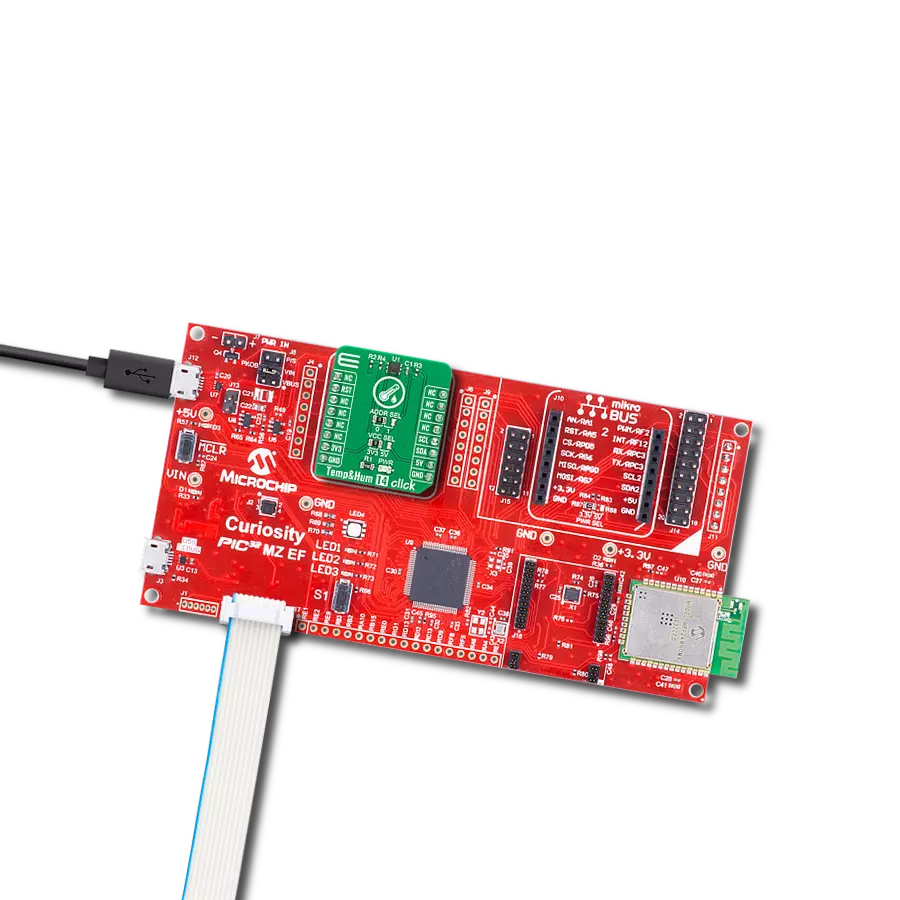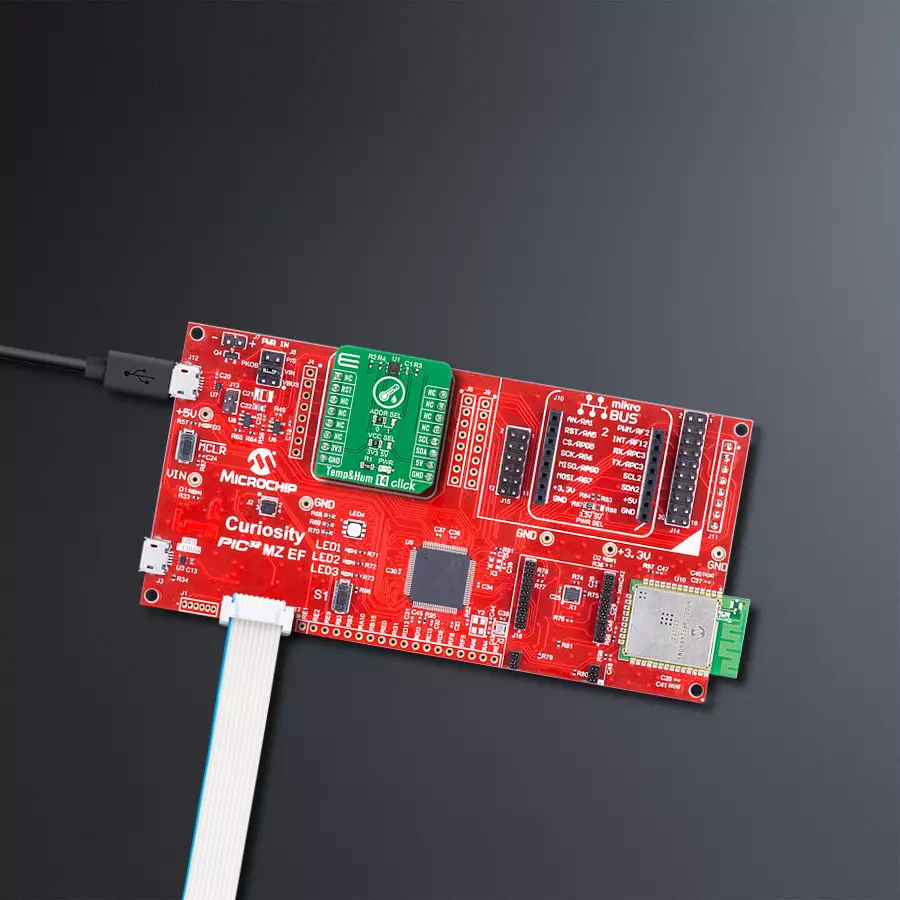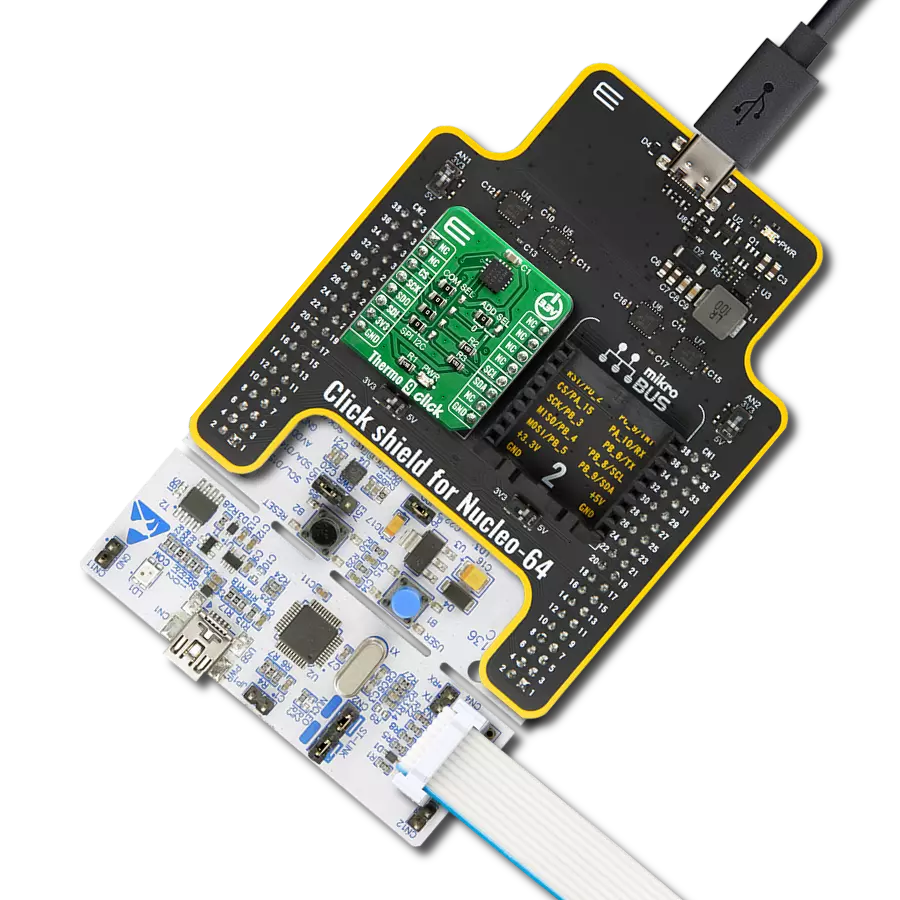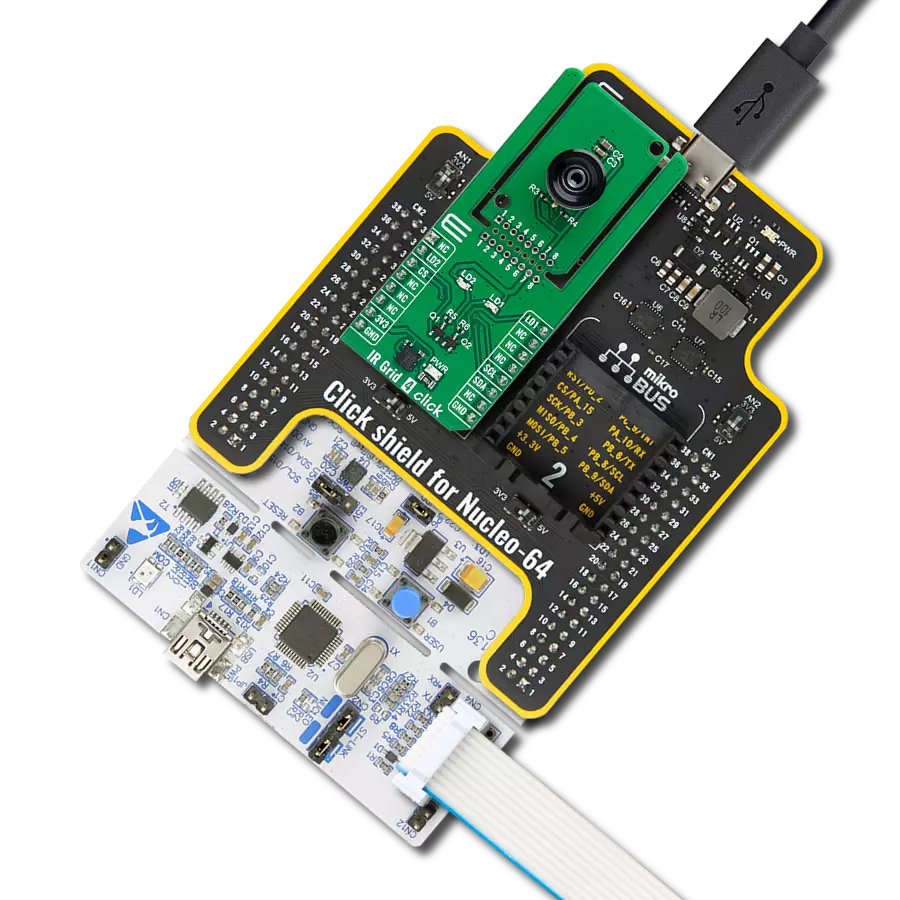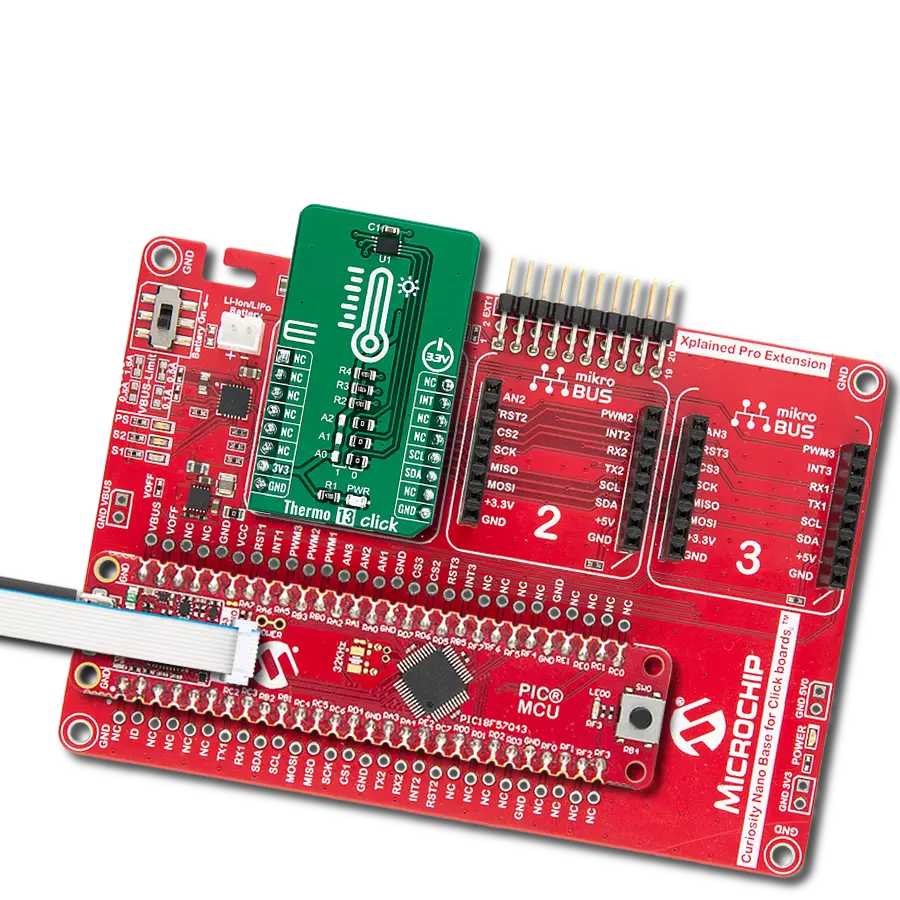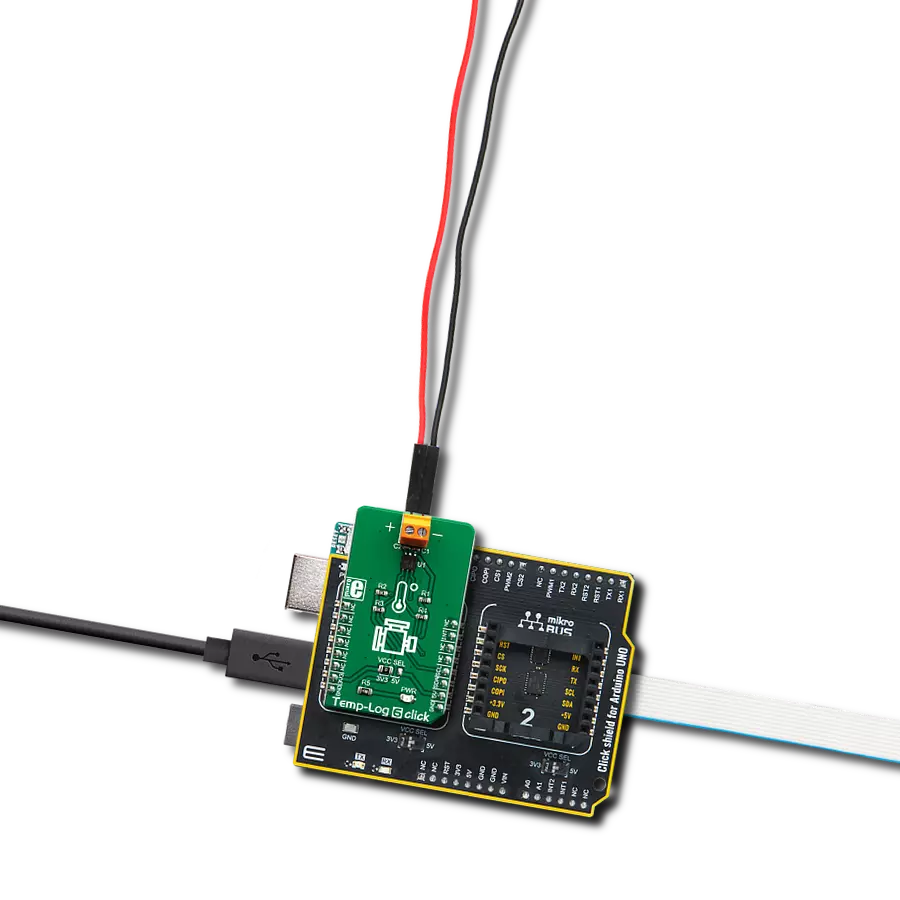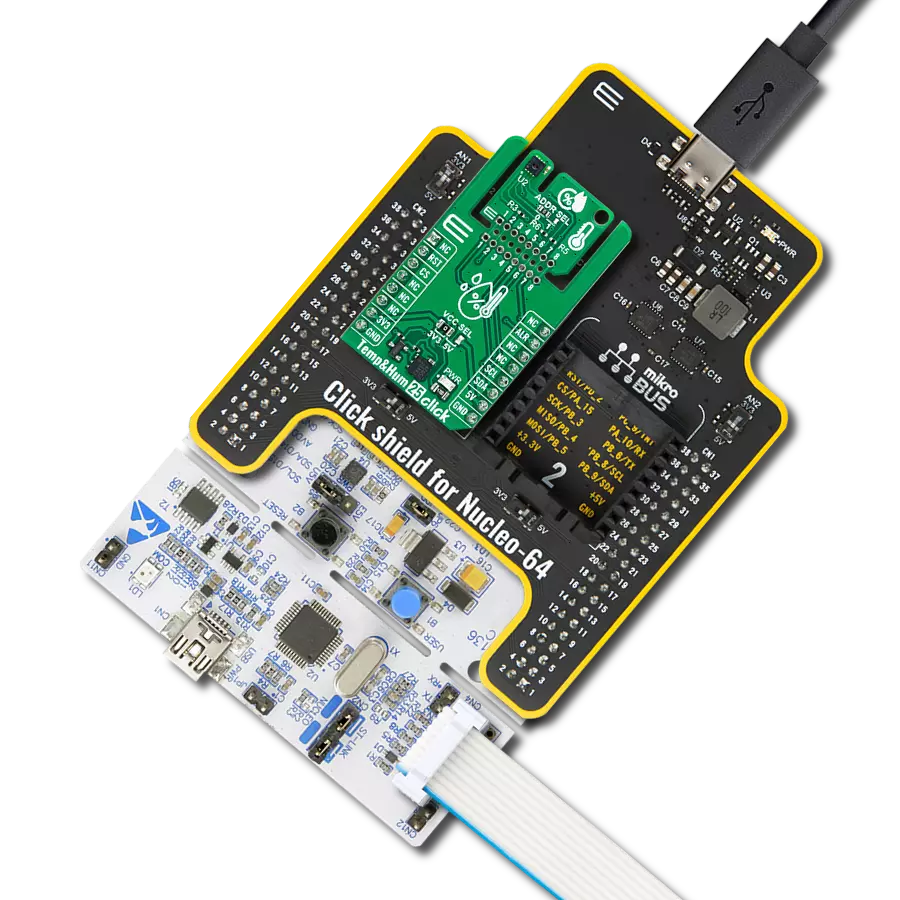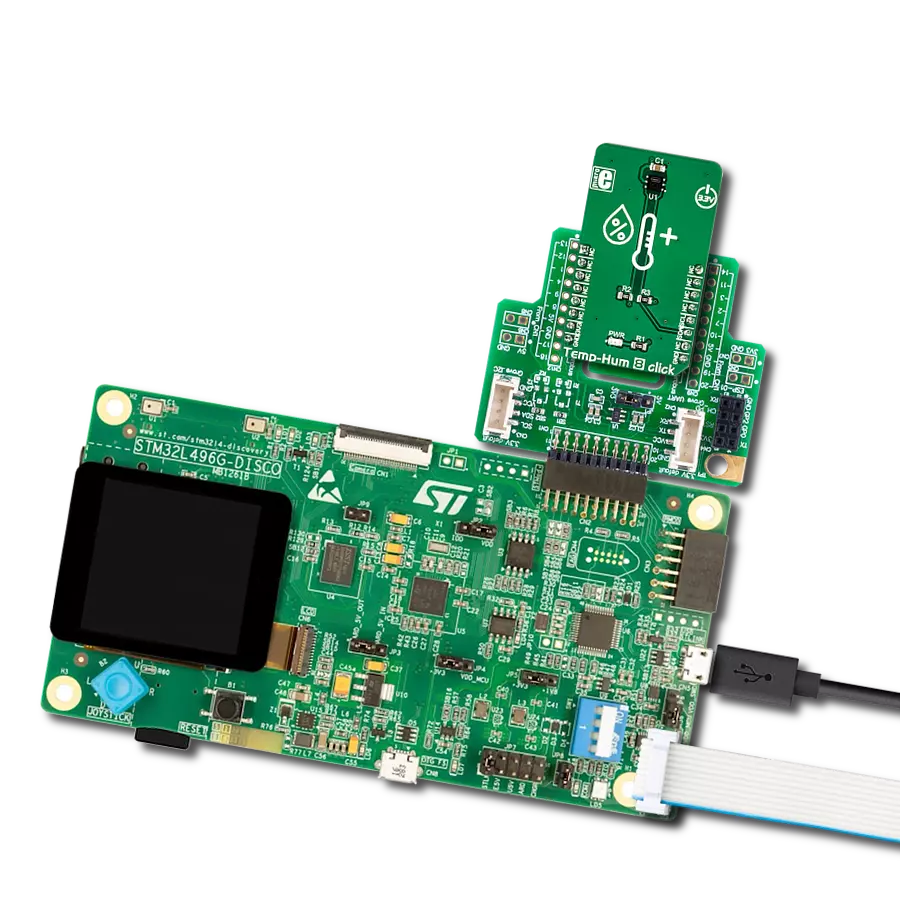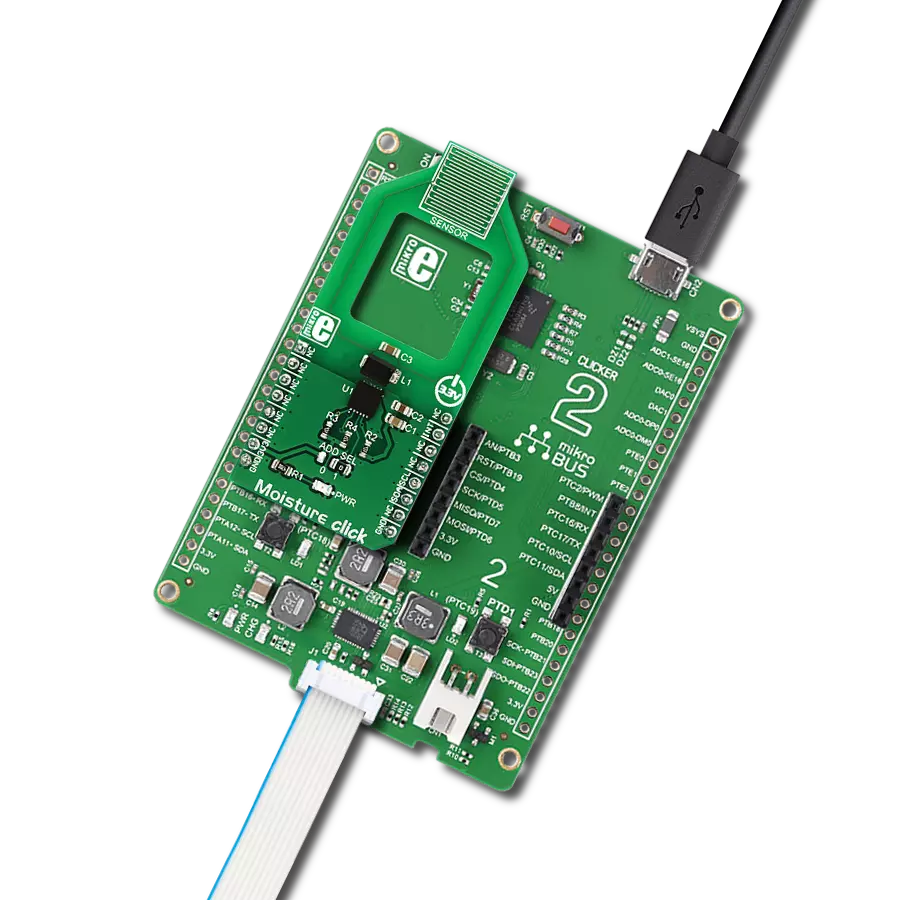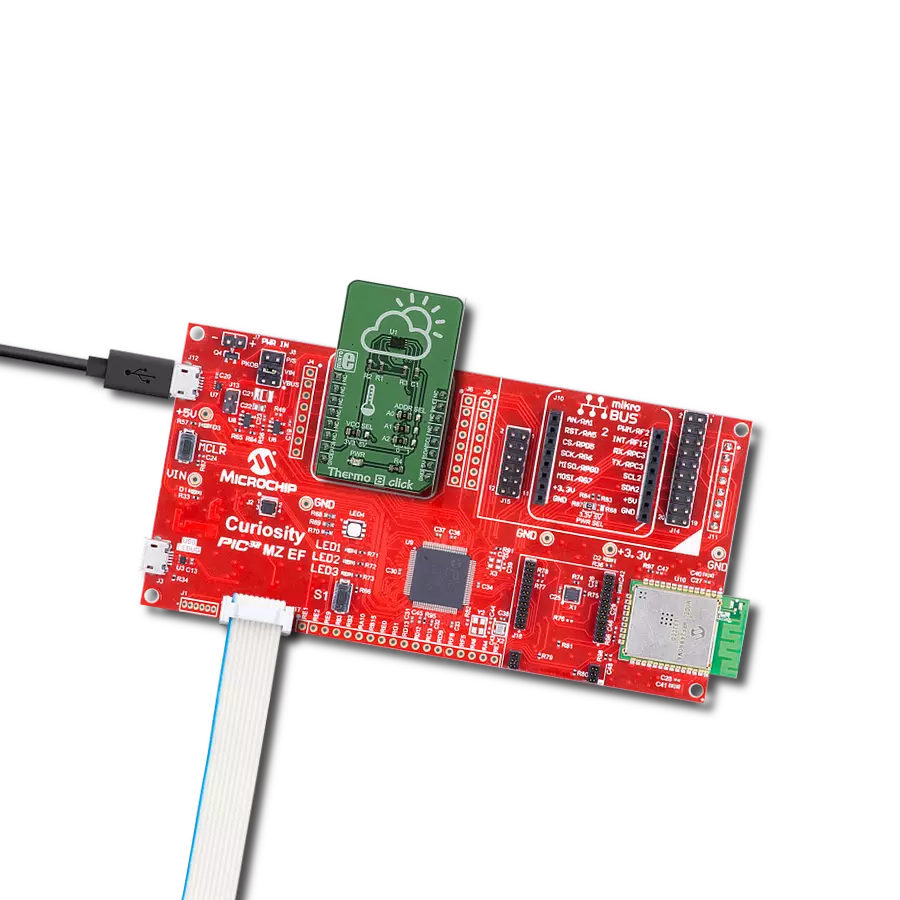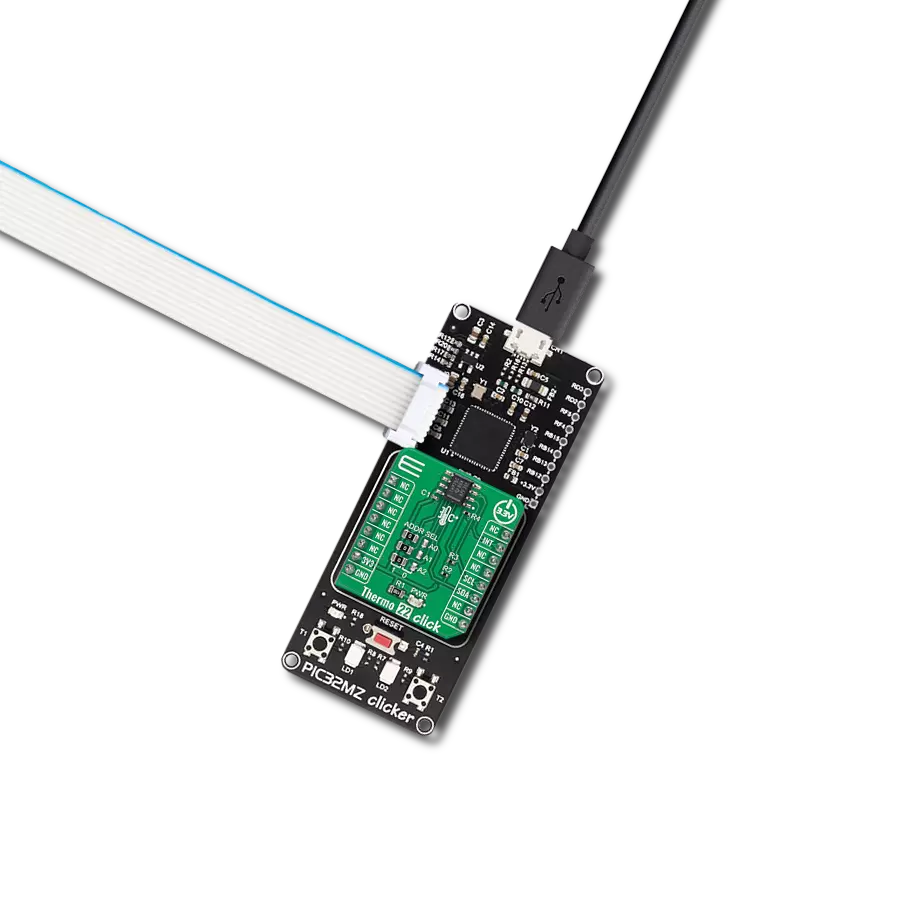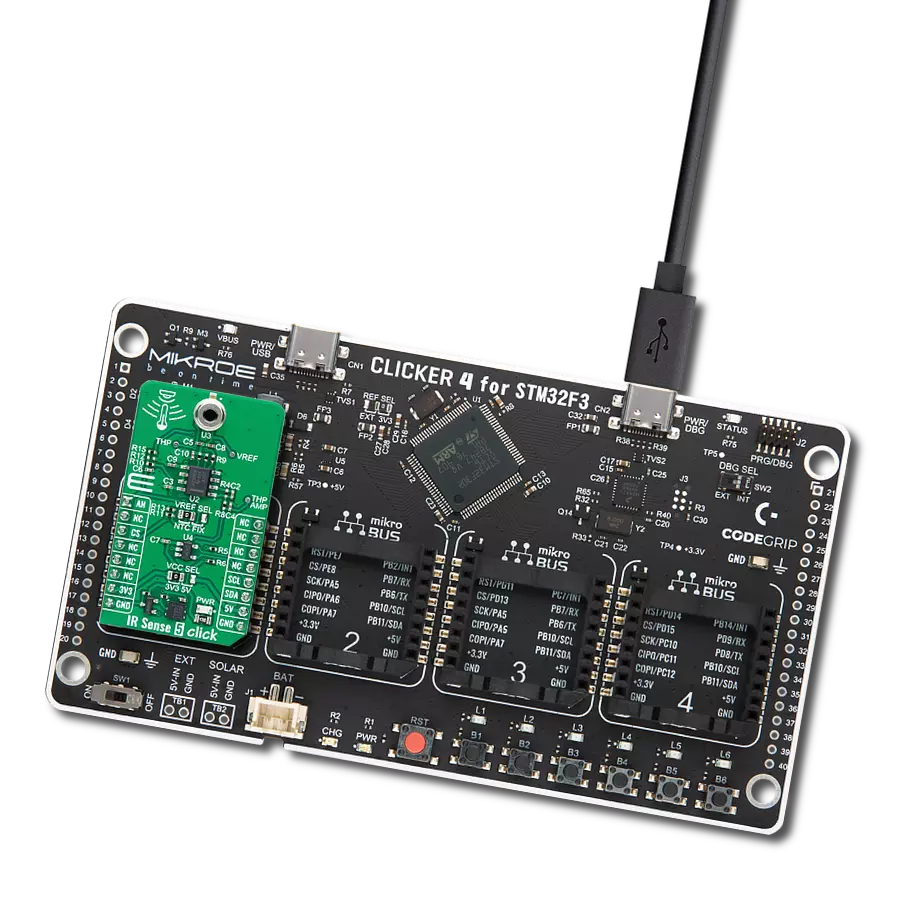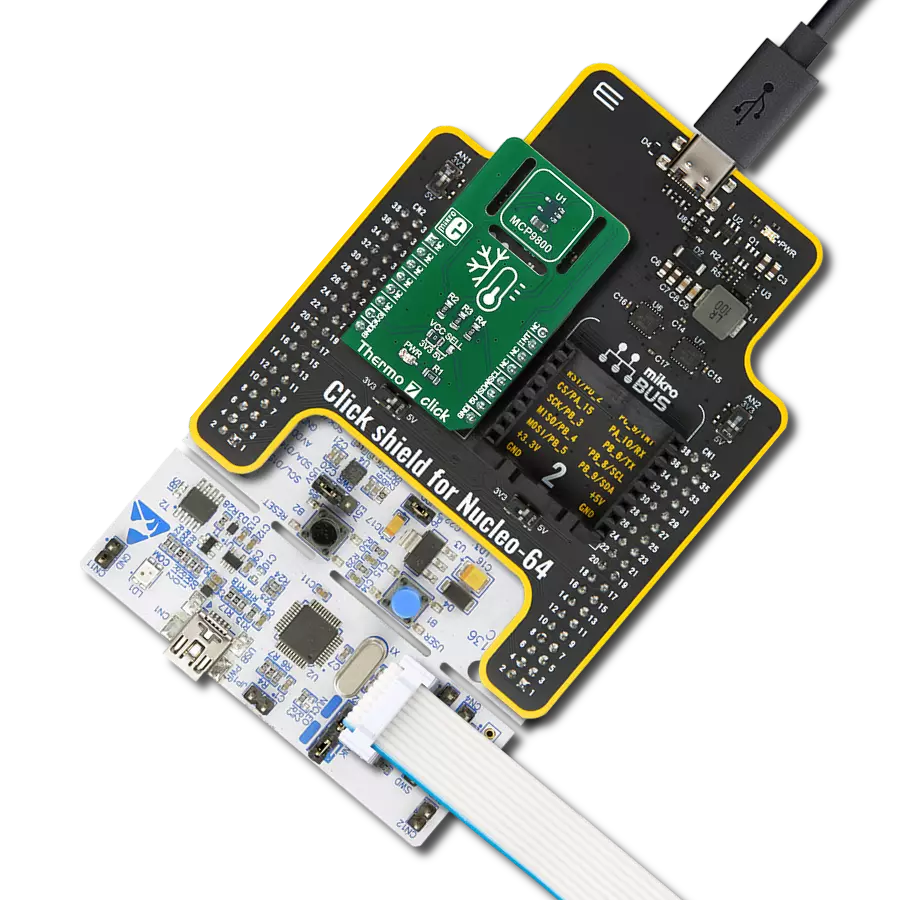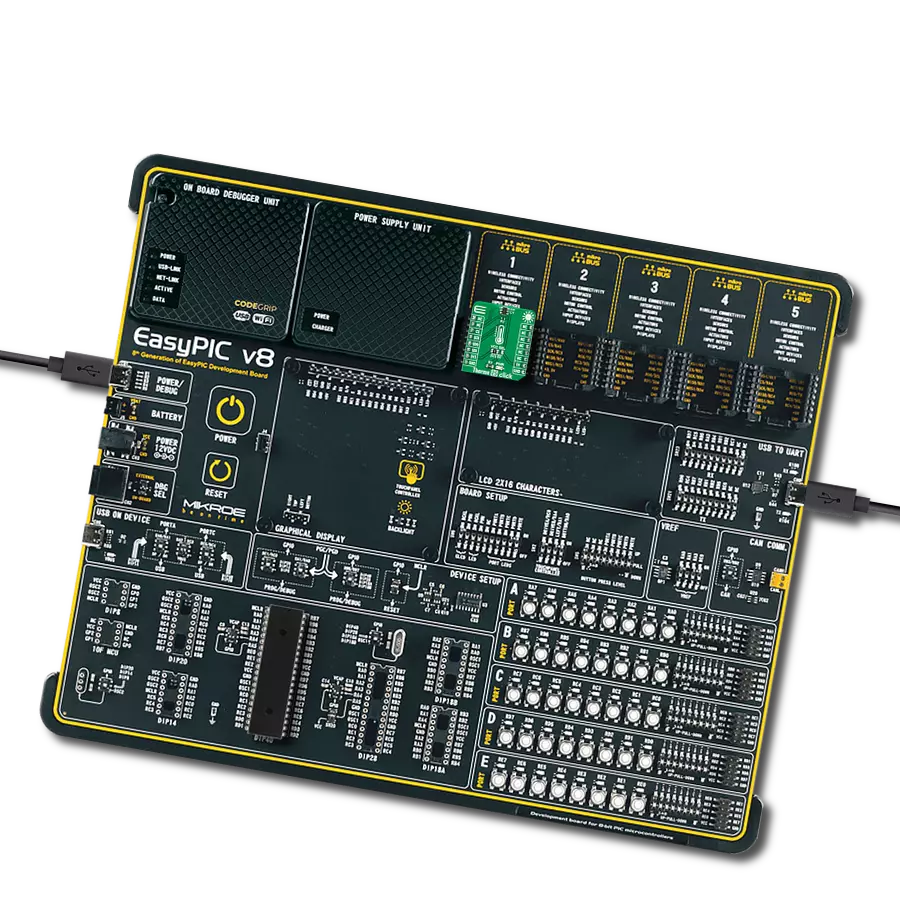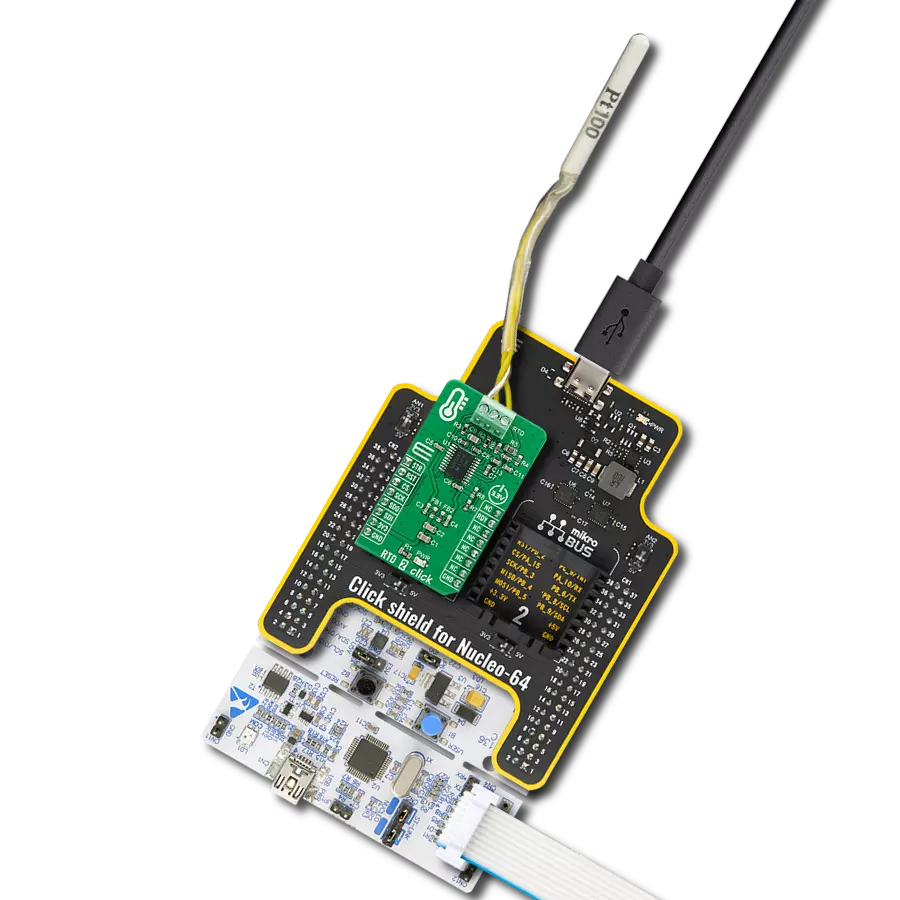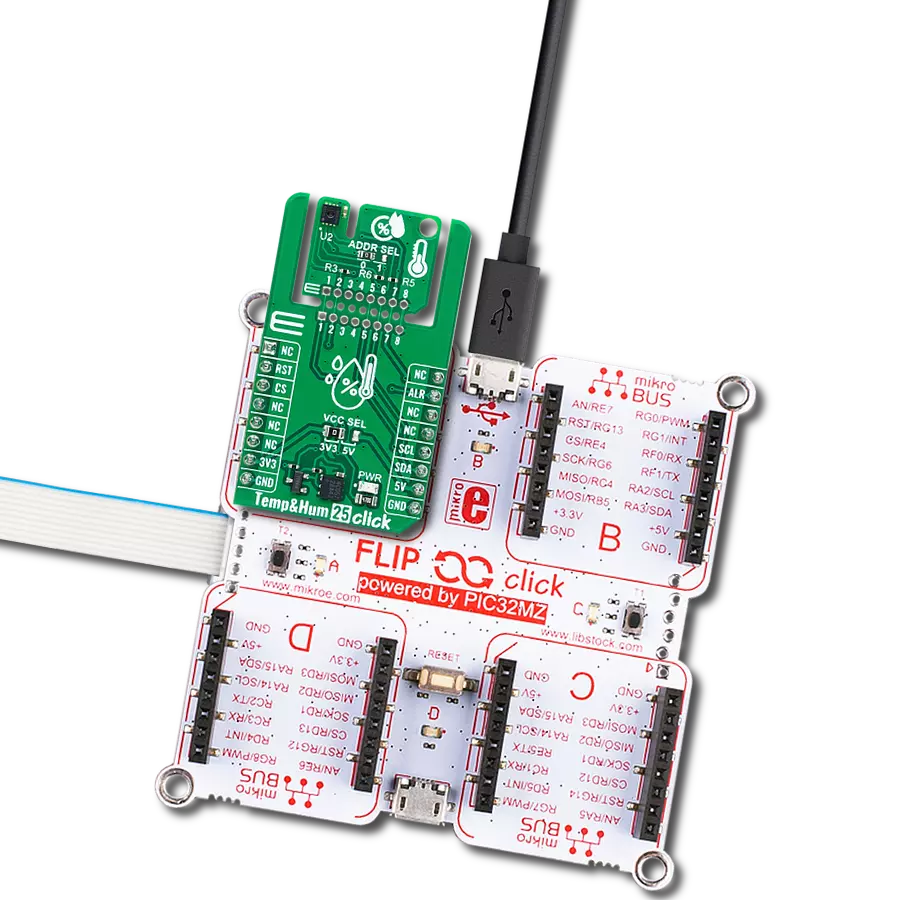Count on our climate solution to provide valuable insights into temperature and humidity, contributing to a smarter and more sustainable future.
A
A
Hardware Overview
How does it work?
Temp&Hum 14 Click is based on the HTU31D, a digital relative humidity sensor with temperature output from TE Connectivity. Both sensors inside the HTU31D are individually calibrated, compensated, and tested. The humidity can be measured within a range of 0 to 100 %RH, while the temperature sensor is designed for a range of -40 to 125 °C. The typical accuracy for humidity is ± 2 %RH in the measuring range of 20 up to 100 %RH at ambient temperature and ±0.2 °C for temperature between 0 - 100 °C with power consumption down to 3.78μW. This Click board™, an I2C configurable environmental sensor, is characterized by high reliability and full interchangeability with no calibration required in standard conditions. It has a quick recovery time after long periods in the saturation phase, low power
consumption, and fast response time. Also, this sensor provides sustained performance even when exposed to extreme temperatures up to 125°C and humidity environments. Temp & Hum 14 Click communicates with MCU using the standard I2C 2-Wire interface with a maximum frequency 10MHz. The HTU31D can answer 2 I2C addresses and allows the choice of the least significant bit (LSB) by positioning SMD jumpers labeled as ADDR SEL to an appropriate position marked as 0 and 1. In addition to this feature, this Click board™ also contains additional functionality routed to the RST pin on the mikroBUS™ socket. The RST pin can generate a sensor reset with a minimum pulse duration of 1 μs required to trigger this function. The HTU31D also offers a diagnostic register that can be used to check whether
the values for humidity and temperature are outside the specified range. The CRC check (Cyclic Redundancy Check) ensures secure data transmission. The humidity and temperature signal response time, as well as the recovery time (after complete condensation), are within a range of a few seconds. This Click board™ can operate with either 3.3V or 5V logic voltage levels selected via the VCC SEL jumper. This way, both 3.3V and 5V capable MCUs can use the communication lines properly. Also, this Click board™ comes equipped with a library containing easy-to-use functions and an example code that can be used as a reference for further development.
Features overview
Development board
Curiosity PIC32 MZ EF development board is a fully integrated 32-bit development platform featuring the high-performance PIC32MZ EF Series (PIC32MZ2048EFM) that has a 2MB Flash, 512KB RAM, integrated FPU, Crypto accelerator, and excellent connectivity options. It includes an integrated programmer and debugger, requiring no additional hardware. Users can expand
functionality through MIKROE mikroBUS™ Click™ adapter boards, add Ethernet connectivity with the Microchip PHY daughter board, add WiFi connectivity capability using the Microchip expansions boards, and add audio input and output capability with Microchip audio daughter boards. These boards are fully integrated into PIC32’s powerful software framework, MPLAB Harmony,
which provides a flexible and modular interface to application development a rich set of inter-operable software stacks (TCP-IP, USB), and easy-to-use features. The Curiosity PIC32 MZ EF development board offers expansion capabilities making it an excellent choice for a rapid prototyping board in Connectivity, IOT, and general-purpose applications.
Microcontroller Overview
MCU Card / MCU

Architecture
PIC32
MCU Memory (KB)
2048
Silicon Vendor
Microchip
Pin count
100
RAM (Bytes)
524288
Used MCU Pins
mikroBUS™ mapper
Take a closer look
Click board™ Schematic

Step by step
Project assembly
Software Support
Library Description
This library contains API for Temp&Hum 14 Click driver.
Key functions:
temphum14_set_conversion- The function set conversion a single temperature and humidity conversion and select data resolution to the HTU31Dtemphum14_read_t_and_rh- The function read temperature and humidity data of the HTU31Dtemphum14_get_temp_and_hum- The function get temperature and humidity value of the HTU31D
Open Source
Code example
The complete application code and a ready-to-use project are available through the NECTO Studio Package Manager for direct installation in the NECTO Studio. The application code can also be found on the MIKROE GitHub account.
/*!
* @file main.c
* @brief TempHum14 Click example
*
* # Description
* This is an example that demonstrates the use of the Temp-Hum 14 Click board.
* Temp-Hum 14 Click board can be used to measure temperature
* and relative humidity.
* All data logs write on USB uart changes every 3 sec.
*
* The demo application is composed of two sections :
*
* ## Application Init
* Initialization driver enables I2C, and
* hardware reset the device and read the serial number.
*
* ## Application Task
* Reading temperature and humidity, and loging it on the USB uart.
*
* @author Stefan Ilic
*
*/
#include "board.h"
#include "log.h"
#include "temphum14.h"
static temphum14_t temphum14;
static log_t logger;
static temphum14_diagn_t status_data;
static float temperature;
static float humidity;
uint32_t ser_numb;
void display_diagnostic ( void ) {
log_printf( &logger, "-----------------------------\r\n" );
log_printf( &logger, "\r\n NVM Error :" );
if ( status_data.nvm_error == TEMPHUM14_STATUS_ON ) {
log_printf( &logger, " Error \r\n" );
} else {
log_printf( &logger, " No Error \r\n" );
}
log_printf( &logger, "\r\n Humidity U/O :" );
if ( status_data.hum_un_over == TEMPHUM14_STATUS_ON ) {
log_printf( &logger, " Under/Overrun \r\n" );
} else {
log_printf( &logger, " No Error \r\n" );
}
log_printf( &logger, "\r\n Humidity Error :" );
if ( status_data.hum_h_err == TEMPHUM14_STATUS_ON ) {
log_printf( &logger, " Below -10%% RH \r\n" );
} else if ( status_data.hum_l_err == TEMPHUM14_STATUS_ON ) {
log_printf( &logger, " Above 120%% RH \r\n" );
} else {
log_printf( &logger, " No Error \r\n" );
}
log_printf( &logger, "\r\n Temperature U/O :" );
if ( status_data.temp_un_over == TEMPHUM14_STATUS_ON ) {
log_printf( &logger, " Under/Overrun \r\n" );
} else {
log_printf( &logger, " No Error \r\n" );
}
log_printf( &logger, "\r\n Temperature Error:" );
if ( status_data.temp_h_err == TEMPHUM14_STATUS_ON ) {
log_printf( &logger, " Below -50 C \r\n" );
} else if ( status_data.temp_l_err == TEMPHUM14_STATUS_ON ) {
log_printf( &logger, " Above 150 C \r\n" );
} else {
log_printf( &logger, " No Error \r\n" );
}
log_printf( &logger, "\r\n Heater Status :" );
if ( status_data.heater_on == TEMPHUM14_STATUS_ON ) {
log_printf( &logger, " ON \r\n" );
} else {
log_printf( &logger, " OFF \r\n" );
}
log_printf( &logger, "-----------------------------\r\n" );
}
void application_init ( void ) {
log_cfg_t log_cfg; /**< Logger config object. */
temphum14_cfg_t temphum14_cfg; /**< Click config object. */
/**
* Logger initialization.
* Default baud rate: 115200
* Default log level: LOG_LEVEL_DEBUG
* @note If USB_UART_RX and USB_UART_TX
* are defined as HAL_PIN_NC, you will
* need to define them manually for log to work.
* See @b LOG_MAP_USB_UART macro definition for detailed explanation.
*/
LOG_MAP_USB_UART( log_cfg );
log_init( &logger, &log_cfg );
log_printf( &logger, "-----------------------------\r\n" );
log_info( &logger, " Application Init " );
log_printf( &logger, "-----------------------------\r\n" );
// Click initialization.
temphum14_cfg_setup( &temphum14_cfg );
TEMPHUM14_MAP_MIKROBUS( temphum14_cfg, MIKROBUS_1 );
err_t init_flag = temphum14_init( &temphum14, &temphum14_cfg );
if ( I2C_MASTER_ERROR == init_flag ) {
log_error( &logger, " Application Init Error. " );
log_info( &logger, " Please, run program again... " );
for ( ; ; );
}
Delay_ms ( 100 );
log_printf( &logger, "-----------------------------\r\n" );
log_printf( &logger, " Hardware Reset \r\n" );
temphum14_hw_reset( &temphum14 );
Delay_ms ( 100 );
ser_numb = temphum14_get_serial_number( &temphum14 );
log_printf( &logger, "-----------------------------\r\n" );
log_printf( &logger, " Serial Number : %lu \r\n", ser_numb );
log_printf( &logger, "-----------------------------\r\n" );
log_printf( &logger, " Software Reset \r\n" );
temphum14_soft_reset( &temphum14 );
Delay_ms ( 100 );
temphum14_get_diagnostic( &temphum14, &status_data );
Delay_ms ( 100 );
display_diagnostic( );
Delay_ms ( 100 );
log_info( &logger, " Application Task " );
log_printf( &logger, "-----------------------------\r\n" );
}
void application_task ( void ) {
temphum14_set_conversion( &temphum14, TEMPHUM14_CONVERSION_HUM_OSR_0_020, TEMPHUM14_CONVERSION_TEMP_0_040 );
Delay_ms ( 10 );
temphum14_get_temp_and_hum( &temphum14, &temperature, &humidity );
Delay_ms ( 10 );
log_printf( &logger, " Temperature : %.2f C \r\n", temperature );
log_printf( &logger, " Humidity : %.2f %% \r\n", humidity );
log_printf( &logger, "-----------------------------\r\n" );
Delay_ms ( 1000 );
Delay_ms ( 1000 );
Delay_ms ( 1000 );
}
int main ( void )
{
/* Do not remove this line or clock might not be set correctly. */
#ifdef PREINIT_SUPPORTED
preinit();
#endif
application_init( );
for ( ; ; )
{
application_task( );
}
return 0;
}
// ------------------------------------------------------------------------ END
Additional Support
Resources
Category:Temperature & humidity
